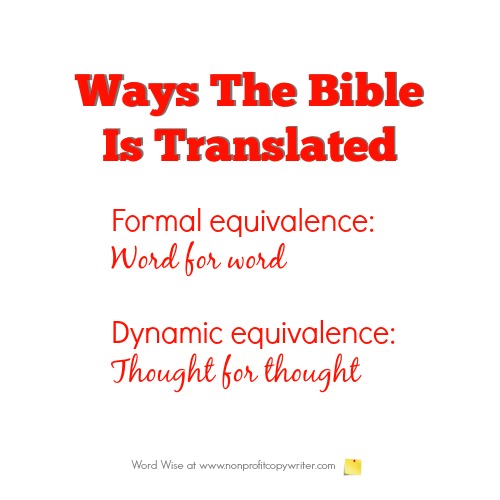Save Time: Get 5 Simple Writing Tips
you can put to use in 10 minutes
Understanding Bible Translations: An Overview for Writers
Award-winning writer Kathy Widenhouse has helped hundreds of nonprofits and writers produce successful content , with 750K+ views for her writing tutorials. She is the author of 9 books. See more of Kathy’s content here.
By understanding Bible translations and how they work, you can write better.
I’ve found this to be true in my own writing life in at least two ways.
First, as I compare different translations of a passage, I understand the scriptural principle better – which in turn gives me clarity as I write.
Second, by reading a few translations of a passage I get ideas for other devotionals, blog posts, or articles.
The Bible is available in hundreds of English translations –
more than 900, according to the American Bible Society.
Understanding Bible Translations: Why Are There So Many?
Reason #1: Language Is Used Differently Over Time
The Bible is translated or revised as to how a people or language group speaks and reads at a contemporary time. If a modern English reader were to pick up an original 1611 King James Version (KJV) of the Bible, he would find it virtually unreadable.
The KJV of 1611 used the common language of the people at that time. Today, of course, English is spoken and written differently than in 1611. Hence, publishers make the Bible available to readers in a way that they can understand it.
Reason #2: Language Is Translated Using Different Methods
There are different methods for converting the Bible’s source text in Hebrew, Aramaic, and Greek into another language, such as English.
You can think of these methods as on a continuum. On one far end of the translation scale is what’s called “formal equivalence.” On the polar opposite end of the translation scale is “dynamic equivalence.” Each approach has benefits.
Formal Equivalence (also called “literal translation”)
These versions translate the Bible using a word-for-word approach. Two examples are the New American Standard Bible and King James Version Bible.
Advantages of formal equivalence
- Accuracy
- Clarity in communicating doctrinal principles
Dynamic Equivalence (also called “functional translation")
These versions translate the Bible using a thought-for-thought method. Examples are the New International Version and the New Living Translation.
Advantages of dynamic equivalence:
- Readability
- Up-to-date cultural currency
(Use these tips for citing the Bible as you write.)
If You Want to Be Technical About It…
There are differences between a Bible translation, a Bible version, and a Bible paraphrase.
- A translation is a rendition in which the content is read and analyzed in the original language and then converted into a second language (example: Greek to English).
- A version (or “revision”) is a rendition in which the content from an existing translation is read and analyzed and then converted into a second rendition of that same language (example: English to English).
- A paraphrase is a rendition that is neither word-for-word or thought-for-thought, but renders the text in the writer’s own words – just as to paraphrase any other written work means “to put into your own words.” Modern examples of Bible paraphrases are The Living Bible and The Message.
You can compare different translations easily using an online tool like Bible Gateway, Bible Study Tools, or The Bible App (YouVersion.)
More Tips for Christian Writing
Christian Writing Resources for content creators, freelancers, bloggers ...
Just Take A Step: a Devotional Bible study for the busy and overwhelmed ...
What Makes Good Christian Writing?
Tips for citing the Bible in articles, blogs, devotionals, more ...
Christian Writers Market Guide: do you need it?
What Can a Sci-Fi Writer Teach Me about the Christian Market?
Writing Devotionals That Stick: a step-by-step writing guide ...
More Christian writing tips on our Pinterest board ...
Return from Understanding Bible Translations to Nonprofit Copywriter home
As an Amazon Associate I earn from qualifying purchases.
Share This Page

Named to 2022 Writer's Digest list
BEST GENRE/NICHE WRITING WEBSITE


Stop Wasting Time!

Grab your exclusive FREE guide, "5 Simple Writing Tips You Can Put to Use in 10 Minutes or Less"











